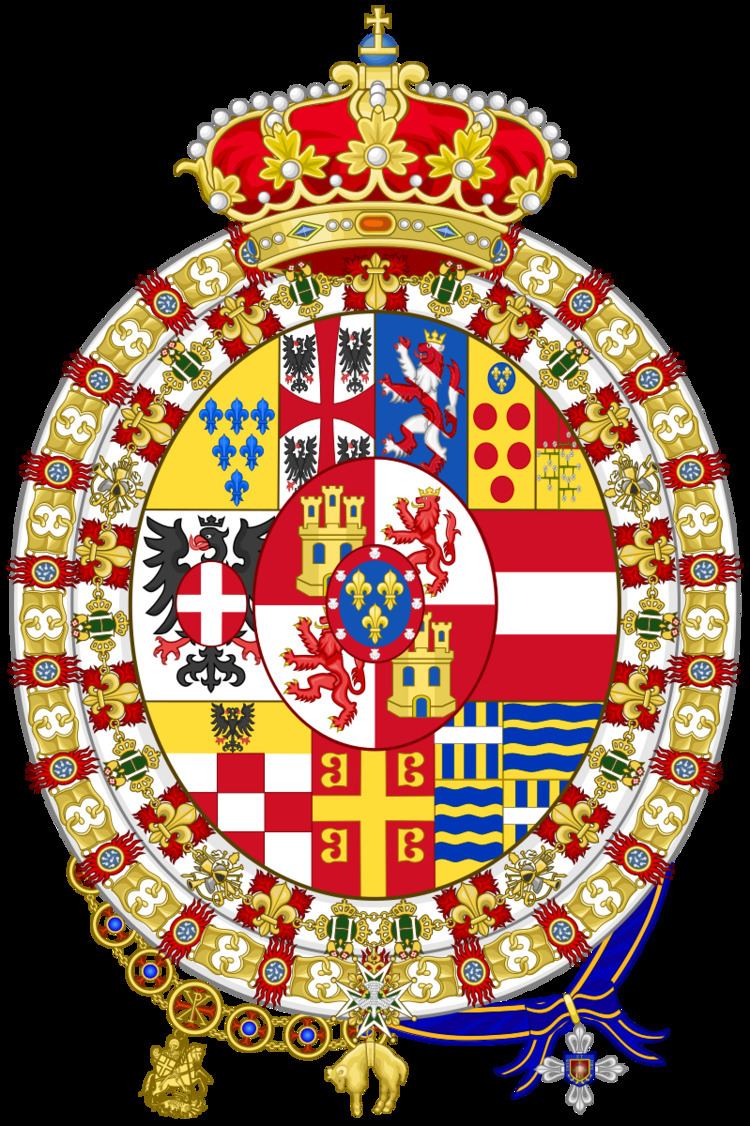Parent house House of Bourbon | Founded 18 October 1748 | |
 | ||
Titles Duke of ParmaDuke of GuastallaDuke of LuccaKing of EtruriaDuke of San JaimeCount of BardiGrand Duke of Luxembourg | ||
The House of Bourbon-Parma (Italian: Casa di Borbone di Parma) is an Italian cadet branch of the House of Bourbon. It is thus descended from the French Capetian dynasty in male line. The name of Bourbon-Parma comes from the main name (Bourbon) and the other (Parma) from the title of Duke of Parma. The title was held by the Spanish Bourbons as the founder was the great-grandson of Duke Ranuccio II Farnese, Duke of Parma.
Contents
Duchy of Parma
The Duchy of Parma was created in 1545 from that part of the Duchy of Milan south of the Po River, as a fief for Pope Paul III's illegitimate son, Pier Luigi Farnese, centered on the city of Parma. In 1556, the second Duke, Ottavio Farnese, was given the city of Piacenza, becoming thus also Duke of Piacenza, and so the state was thereafter properly known as the Duchies of Parma and Piacenza.
The Farnese family continued to rule until their extinction in 1731, at which point the duchy was inherited by the young son of the King of Spain, Charles, whose mother Elisabeth was a member of the Farnese family. He ruled until 1735 during the War of the Polish Succession, when Parma was ceded to Emperor Charles VI in exchange for the Two Sicilies.
Temporary Habsburg rule
The Habsburgs only ruled until the conclusion of the Treaty of Aix-la-Chapelle in 1748, when it was ceded back to the Bourbons in the person of Philip, Charles's younger brother. As duke Philip, he became the founder of the House of Bourbon-Parma.
In 1796, the duchy was occupied by French troops under Napoleon Bonaparte. In the Treaty of Aranjuez of 1801, duke Ferdinand formally agreed to cede the duchy to Napoleon. The territories were integrated into the Cisalpine Republic until 1802, the Italian Republic, from 1802 until 1805, and the Kingdom of Italy, from 1805 until 1808, until in 1808 the French Empire annexed them and formed out of them the Département of Taro.
In 1814, the duchies were restored under Napoleon's Habsburg wife, Marie Louise, who was to rule them for her lifetime. The duchy was renamed the duchy of Parma, Piacenza and Guastalla, the name that it retained until the end.
Return to the Bourbons
After Marie Louise's death in 1847, the duchy was restored to the Bourbon-Parma line, which had been ruling the tiny duchy of Lucca. The Bourbons ruled until 1859, when they were driven out by a revolution following the Sardinian victory in their war against Austria.
The duchies of Parma, Piacenza and Guastalla and the duchy of Lucca joined with the Grand Duchy of Tuscany and the duchy of Modena to form the United Provinces of Central Italy in December 1859, and were annexed to the Kingdom of Sardinia in March 1860. The House of Bourbon continues to claim the title of duke of Parma to this day. Carlos-Hugo (Carlist pretender to the Spanish throne in the 1970s) held the title from 1977 to his death. His son now claims the title.
House of Bourbon-Parma 1748–1803
During the French ownership of the Duchy of Parma, the title of Duke of Parma was used as an honorary form and style. From 1808, the title was used by Jean Jacques Régis de Cambacérès. He kept the style of Duc de Parme till 1814. Only in 1847 was the actual title restored to the Bourbons, after a period of being held by Marie Louise of Austria, wife of Napoleon I, who was a Habsburg.
Family
Annemarie, Duchess of Parma, born on (1977-12-18) 18 December 1977
Tajlling ten Cate, born on (1975-12-23) 23 December 1975
Viktória, Countess of Bardi, born on (1982-05-25) 25 May 1982
Albert Brenninkmeijer, born on (1974-05-16) 16 May 1974
Grand Duchy of Luxemburg
Since 1964, the House of Bourbon-Parma has reigned agnatically in Luxembourg when upon the abdication of his mother Jean, Grand Duke of Luxembourg, ascended to the throne. Jean was the son of Prince Felix of Bourbon-Parma, a younger son of Robert I of Parma, and Charlotte, Grand Duchess of Luxembourg. Charlotte's descendants have since reigned as the continued dynasty of Nassau.
In October 2000 Jean abdicated the Luxembourgian throne in favour of his eldest son, Henri, Grand Duke of Luxembourg.
